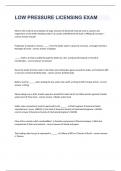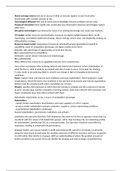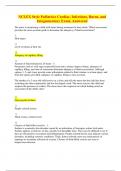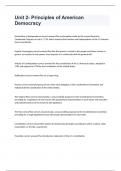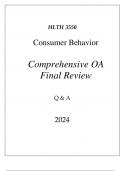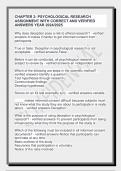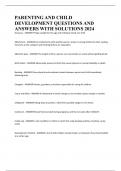week of embryonic development causes which condition in an infant?
a. Sinus dysfunction
b. Esophageal malformation
c. Cleft lip
d. Cleft palate
Rationale: A cleft lip is caused by the incomplete fusion of the nasomedial and
intermaxillary process during the fourth week of embryonic development.
Increased gastrin secretion by the mother in the last trimester of pregnancy may
cause which condition in the infant?
a. Galactosemia
b. Esophageal atresis
c. Meconium ileus
d. Pyloric stenosis
Rationale: Increased gastrin secretion by the mother in the last trimester of pregnancy
increases the likelihood of pyloric stenosis in the infant. The overproduction of gastric
secretions in the infant may be caused by stress-related factors in the mother.
Increased gastrin secretion does not lead to meconium ileus, esophageal atresia, or
galactosemia.
Parents report their 3-week-old infant who eats well and has gained weight began
to vomit forcefully for no apparent reason. What treatment option does the
healthcare professional prepare to educate the parent on?
a. Wheat-free diet
b. A gastric feeding tube
c. Corrective surgery
d. Lactose-free diet
Rationale: This infant is displaying symptoms of pyloric stenosis. The key treatment for
pyloric stenosis is corrective surgery, usually a laparoscopic pyloromyotomy. A feeding
tube is not needed; a wheat-free diet would be indicated for celiac disease or nonceliac
gluten sensitivity; lactose-free diet would be beneficial in lactose sensitivity.
Which term is used to identify a condition in which the developing colon remains
in the upper right quadrant instead of moving to its normal location?
a. Ileocecal displacement
b. Duodenal obstruction
c. Pyloric stenosis
d. Intestinal malrotation
Rationale: Intestinal malrotation is the term used to identify a condition in which rotation
does not occur and the colon remains in the upper right quadrant, where an abnormal
membrane may press on and obstruct the duodenum.
,Which term is used to identify an intestinal obstruction caused by meconium
formed in utero that is abnormally sticky and adheres firmly to the mucosa of the
small intestine?
a. Meconium cecum
b. Meconium obstruction
c. Meconium ileus
d. Meconium vivax
Rationale: Meconium ileus is the term used to identify an intestinal obstruction caused
by meconium formed in utero that is abnormally sticky and adheres firmly to the mucosa
of the small intestine, resisting passage beyond the terminal ileum. The cause is usually
a lack of digestive enzymes during fetal life.
A newborn has meconium ileus. What diagnostic test does the healthcare
professional advise the parents about?
a. A sweat test
b. Pulmonary function studies
c. Colonoscopy
d. Nerve conduction studies
Rationale: Meconium ileus is seen in 20% of children who have cystic fibrosis, so the
newborn needs a sweat test and genetic screening for this disorder. there is no need for
the professional to education the parents on a colonoscopy, pulmonary function studies,
or nerve conduction studies.
Congenital aganglionic megacolon (Hirschsprung's disease) involves inadequate
motility of the colon caused by neural malformation of which nervous system?
a. Sympathetic
b. Somatic
c. Central
d. Parasympathetic
Rationale: A malformation related to the parasympathetic nervous system causes
congenital aganglionic megacolon.
An infant has been diagnosed with intussusception and the student asks the
healthcare professional to explain the condition. What explanation by the
professional is MOST accurate?
a. Fibrosis increases the resistance to blood flow within the portal system.
b. One part of the intestine telescopes into another section of the intestine.
c. Poor colonic motility due to a problem in the PNS.
d. The colon stats in the upper right quadrant instead of moving to its normal location.
Rationale: Intussusception is the telescoping or invagination of portion of the intestine
into another section of intestine. Usually, the ileum invaginates the cecum and part of
, the ascending colon by collapsing through the ileocecal valve. A problem with the PNS
in Hirschsprung's disease leads to poor colonic motility. Intestinal malrotation is the term
used to identify a condition in which rotation does not occur and the colon remains in
the upper right quad. Increased reisistance to blood flow in the portal system leads to
portal hypertension
An infant suddenly develops abdominal pain, becomes irritable, and draws up the
knees. Vomiting occurs soon afterward. The mother reports that the infant
passed a normal stool, followed by one that looked like currant jelly. What
treatment does the healthcare professional prepare the infant for?
a. Corrective surgery
b. Anal dilation
c. Gastric decompression
d. Reduction enema
Rationale: Based on these data, the nurse should suspect intussusception. A standard
therapy for this disorder is a reducing enema so the professional should prepare the
infant (and parents) for this procedure. Corrective surgery, gastric decompression, and
anal dilation are not needed.
Cystic fibrosis is characterized by which symptom?
a. Excessive mucus production
b. Low sodium content in perspiration
c. Abnormally thin exocrine secretions
d. Elevated blood glucose levels
Rationale: Excessive mucus production characterizes cystic fibrosis. However, the
pathophysiologic triad that is the hallmark of cystic fibrosis includes (1) pancreatic
enzyme deficiency, which causes maldigestion; (2) overproduction of mucus in the
respiratory tract and an inability to clear secretions, which cause progressive COPD;
and (3) abnormally ELEVATED sodium and chloride concentrations in sweat. Exocrine
secretions tend to be abnormally THICK and precipitate in the glandular ducts,
obstructing flow. An elevated blood glucose level is not associated with this disorder.
A child has cystic fibrosis (CF). Which medication does the healthcare
professional teach the parents about?
a. Salt tablets
b. Pancreatic enzymes
c. Anti-hypertensives
d. Antibiotics
Rationale: Pancreatic replacement enzymes are administered to people with CF before
or with meals. Salt tablets and anti-hypertensives are not associated with this disorder.
Antibiotics would be used for an infection; people with CF have frequent respiratory
infections.

